In concluding my tour of Piedmont, it is only fitting to finish up with a grape with small plantings here but it is representative of the region every time one brings up the subject of Piedmont. Nebbiolo needs no introduction. To the locals, Nebbiolo in Piedmont is like what Pinot Noir is to the Burgundians.
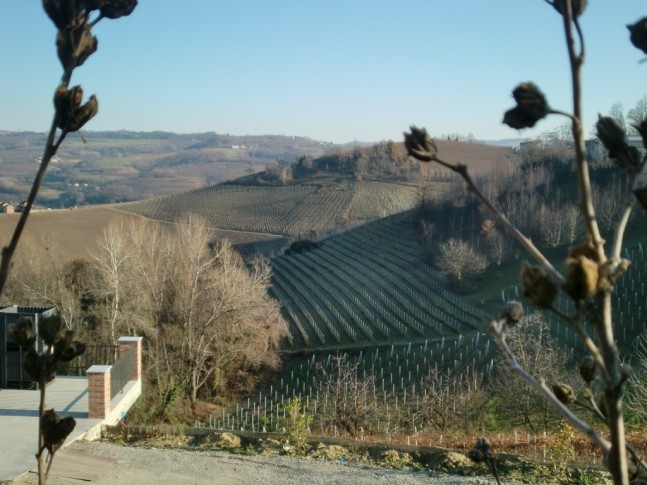
The sights of Nebbiolo on slopes
In fact, taking after the Burgundians, the Piedmontians have separated their land into crus (plots). I was told by a local that the Pinot Noir and Nebbiolo link is established further when the King of Savoy asked the Duke of Burgundy for advice on how to make wines when Nice and Piedmont were once united. That was how the wines of Piedmont was transformed from sweet to dry. The Burgundy-Peidmont kingdom link is historically true but I do not know if they shared any winemaking-ties before.
What have I learned about Nebbiolo in Piedmont? There is abundant literature about the subjects, of Nebbiolo, Barolo and Barbaresco. However, there are some points I would like to add from my observations and dealings with the local producers.
Nebbiolo grows best between 250 to 400 metres. Langhe resides at around 350 metres. In the past, the growers of Barolo would identify the best plots for growing Nebbiolo as those that receive the most sunshine as the grape requires more hang time. This is usually mid-slopes with a south and south-west facing exposition. They would notice that in the spring, after a cold snowy winter, certain plots of land would melt the snow quicker than others. These sites would then be planted with Nebbiolo which is frost-prone. The fog (nebbie), which the land is known for, comes into the land during November. This is around the time of harvesting the Nebbiolo grape, which makes it difficult to see in front of you three rows away. The fog prevents the grapes from drying out and does not cause much disease on the grapes due to its resistance to botrytis.
With pedicles (stems) of 8 cm long, this is one grape which droops a lot on the canes causing the grapes to be very close to the ground. Nebbiolo has larger leaves than Dolcetto and tends to have canes that grow upwards. Although the grape is high in acid and tannins, the grape does not contain much colour pigments. It has thick but tough skins, resulting in a wine that has orange rims as early as 2 years of age. It is the earliest grape in Piedmont to bud, around the 15th of April and is the last to ripen.
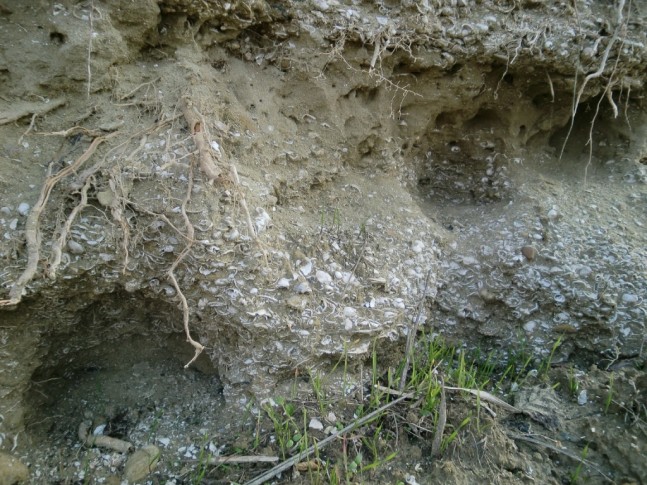
Soils at Matteo Corregia Notice the friable sand and chalky structure and the little seashells sticking out Perfect
The different communes
Barolo has often been portrayed as the King of Piedmont and Barbaresco as the queen. Barbaresco is considered as being more feminine and gentler in style, with shorter aging capabilities. However, I found characteristics and quality of Barbaresco to be comparable to that of Barolo. It can be as tannic as Barolo. One should not be too quick to think that Barolo is more structured and Barbaresco as being more elegant. In a blind tasting, it is possible to find examples of Barolo that mirror the that of Barbaresco. The fruit from La Morra in Barolo can be passed off as a Barbaresco. Fruit from the south of Barbaresco is more structured and becomes less perfumed as the soils become much heavier and less sandy away from the river.
From my time spent there, I theorised that it is possible to find Barolos that taste like Barbarescos but it is harder, although not impossible, to do the opposite. This is because Barolo is more than two time the size of Barbaresco. Barbaresco ripens earlier than Barolo due to the vineyards getting more heat from lower average altitudes of 240 meters (in the township of Barbaresco as Neive and Treiso are higher). Being next to the Tanaro River, Barbaresco receives extra warmth from the reflection of the river’s surface. Both Barolo and Barbaresco are predominantly calcareous soils except that there is more limestone marl and clay in Alba than sand in Barbaresco.
There is more to Nebbiolo than just Barolo and Barbaresco. There is also Gattinara and Ghemme which I did not have a chance to visit. To summarize what I have learnt about the main DOCG/DOCs in Piedmont:
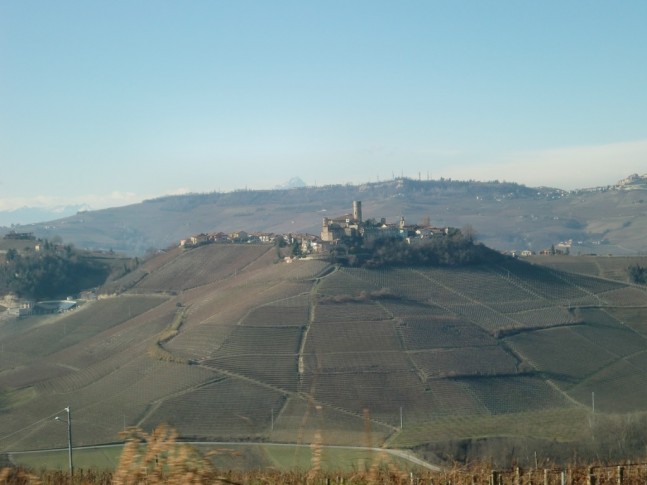
A view from Barolo on a clear day
Barolo DOCG – There are about 941 producers in Barolo producing 13 million bottles annually. Generally, it is a more structured wine than the other Nebbiolos. Quality is dependent on the exposition of the hills with South and South-west being the better ones. Soils play a part as well. My guide, Robert, told me that in soils with a mixture of sand and clay, he would give it 15 years. In more clayish soils such as those of Serralunga d’Alba, it can last up to 25 years while those in the sandy soil of La Morra can do up to 5-6 years. I was also told that part of the law is that Nebbiolo is not allowed to be planted on North-facing slopes in Barolo. My favourite Barolos are floral with characteristics of dried flower petals. Yet it retains an additional cedar and liquorice aroma that comes from wood aging. In terms of the fruit spectrum, we are looking at more dark fruits like blackberries and prunes.
Barbaresco DOCG – There is so much value to be found in Barbaresco as the prices are substantially lower than Barolo. Barolo is around 2 times the price of Barbaresco but this also depends on producer. Yet, quality is not compromised. The differences between Barolo and Barbaresco are subtle. The only reason why Barbaresco have not reached the same status and prices as Barolo is due to the lack of promotion in the royal courts of Turin among the nobility and the House of Savoy. With 75 single crus and production of 13 000 hectares, Barbaresco is not far from the Barolo zone – around 6 kilometres. Barbaresco has around 450 producers producing 4 million bottles annually. The grapes in Barbaresco are grown around 200 to 400 meters above sea level and the soils are clay which are rich in calcium.
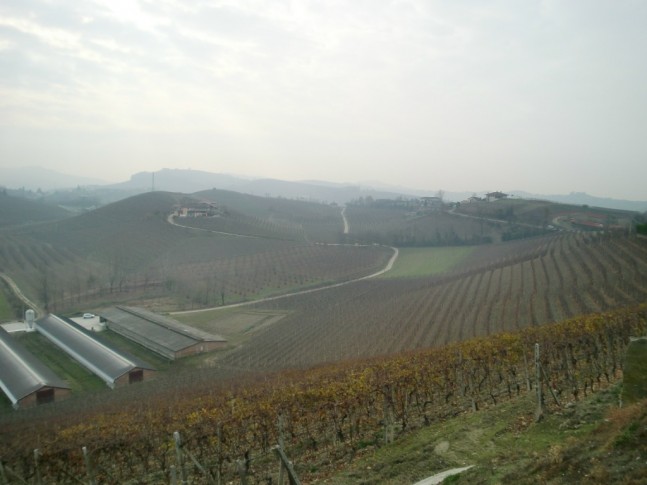
A foggy day at Barbaresco which is why the land is known for nebbia the fog thus the grape name nebbiolo
Nebbiolo d’Alba DOC – For areas which fall outside the Barolo and Barbaresco zone, producers can label their Nebbiolo as Nebbiolo d’Alba. Depending on the age of the vines, there are some versions can be exceptional. Colour on the Nebbiolo d’Alba seems lighter than Barolo or Barbaresco. I found that generally, the wines are spicier, earthier with that aroma of cracked black pepper.
Roero DOCG – With an area that is two times the size of Barolo and Barbaresco, the production is small – around 800 000 bottles. The price of the Riserva can rival that of some Barolos. Due to its sandier soils, I would call Roero DOCG more elegant than rustic. Floral and fruitier aromas accompany a lighter structure compared to Barolo or Barbaresco. Some Roero DOCG could pass off as a Barbaresco in structure depending on the geography of where the grapes are grown – nearer or further from the Tanaro River.
| Wine | Grape | Min. Alch | Aging | Notes |
| Barolo DOCG | Nebbiolo | 13% | 38 months of which 18 months is in wooden vessel. The remaining months is in any vessel of the producer’s choice. | Can be declassified as Langhe Nebbiolo DOC. |
| Barolo Riserva DOCG | 13% | 62 months of which 18 months is in wooden vessel. The remaining months is in any vessel of the producer’s choice. | ||
| Barbaresco DOCG | Nebbiolo | 12.5% | 26 months of which 9 months is in wooden vessel | Can be declassified as Langhe Nebbiolo DOC. |
| Barbaresco Riserva DOCG | 12.5% | 50 months of which 9 months is in wooden vessel | ||
| Nebbiolo d’Alba DOC | Nebbiolo | 12% | 12 months | Can be declassified as Langhe Nebbiolo DOC. 12.5% alcohol with vineyard name is mentioned. |
| Nebbiolo d’Alba Superiore DOC | 12.5% | 18 months of which 6 months is in wood. | 13% alcohol with vineyard name is mentioned. | |
| Roero DOCG | Minimum 95% Nebbiolo. | 12.5% | 20 months of which 6 months is in wood. | Can be declassified as Langhe Nebbiolo DOC. |
| Roero Riserva DOCG | 12.5% | 32 months of which 6 months is in wood. | ||
| Langhe Nebbiolo DOC | Minimum 85% Nebbiolo, 15% similar coloured permitted varieties in Piedmont. | 11.5% | No requirement. | Consists of the areas of Barolo, Barbaresco, Nebbiolo d’Alba, Roero and more. |
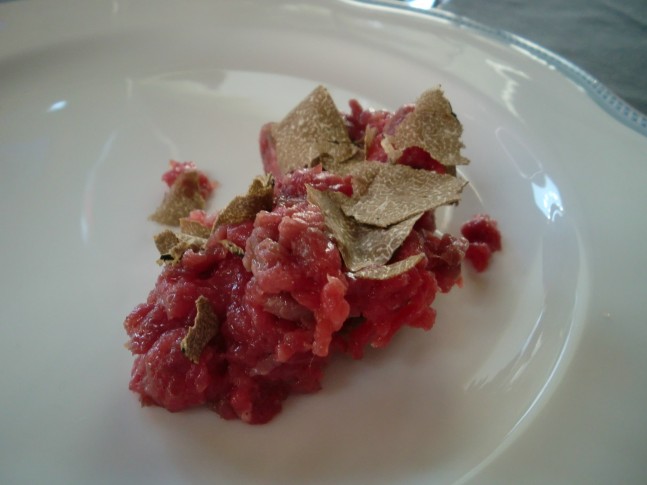
Carpaccio with Truffles Picture this now with Nebbiolo
Aging Nebbiolo & Matching with food
It is written that due to the high amount of astringent tannins, Nebbiolo is a wine that should be drank old and not young so that the tannins mellow out. However, I have found many recent examples in the region that are approachable in its youth. No longer do I believe that Nebbiolo is a wine that requires aging before drinking. I believe that time has allowed the growers and producers in the region to gain the necessary knowledge and experience in controlling the harsh tannins of the grape. Good producers have mastered proper tannin management and have balanced colour extraction with temperature control to obtain aromatics.
If you wish to age it before drinking, a guideline would be to drink Barolo within 10 to 14 years while Barbaresco is within 8 to 12 years. According to my guide Robert, Piedmont Nebbiolo starts to evolve within the 6 years from the date of harvest (vintage date) before plateauing and then after 13 to 16 years from the vintage date, it starts to evolve again. I was told by some that you can keep well-made Barolos and Barbarescos in good years for 30 years. My preference is leaning away from old Barolo and Barbarescos. I have tasted some 13 year old Barolos before and I am not a fan of those extremely rustic, earthy flavours. Nebbiolo can be a highly aromatic grape and those charming aromatics are lost with age.
Also, Nebbiolo is no Pinot Noir. It does not have that unique Pinot smell to it. I found that mid-priced Nebbiolos made under the watchfulness of skilled producers are strongly aromatic, floral and complex, even in its youth. I dare say that the indescribable complex aroma is that unique Nebbiolo aroma.
It would be interesting to see how the more modern Nebbiolos stand the test of time. When I say modern, I mean Nebbiolo that goes through shorter macerations and aging in barriques versus the more traditional 30 day maceration and aging in big Slovenian barrels or chestnut. It is hard to very see the whole evolution of Nebbiolo in Piedmont because most producers do not keep a library of vintages like the French do. This is still a new concept in Barolo. However, the Piedmontians are starting to expand their underground cellars to include space for a museum cellar so that they can observe the evolution of various vintages. You have heard the expression tar, truffles and roses which come with Nebbiolo. Perhaps this is true with the old Nebbiolos but make no mistake! You do not have to wait long these days before Nebbiolo can offer that to you.
Nebbiolo goes very well with gamey dishes such as such as lamb or venison. Roast beef and the local beef tartar, Carne Cruda are absolutely delicious with the acidity of Nebbiolo. Something interesting to pair Nebbiolo with is Cipolle Rípíene (stuffed onions).
Tasting Notes:
A note about my star system
The star system reflects my own preferences and is not meant to build a quality hierarchy. Rather, it is meant to highlight to busy readers who do not have the time to read every tasting note. All wines that are in the write-up are delicious and drinkable wines. If they were not, I would not have taken the time to include them.
No star = wines which I do not mind re-visiting again in the future to revise my opinion. If I were going to a party, I would still buy them to share or have it with meals.
*star = A wine that I would love to drink again tomorrow or next week because it is interesting. If I could, I may age a bottle out of curiosity, just so I can see if it is able to stand the test of time.
** star = A wine that I feel is complex, inviting, concentrated. It has a long length. I would drink it again tomorrow, the day after and in the future. I would love to age it out of curiosity or because I believe it will improve with time.
*** star = I would drink this every day for the next one year if I could afford it. It’s a drink-now and a keeper at the same time.
Barolo Producers
E.Pira e Fìgli by Chiara Boschis
I have not met Chiara in person but was received by her sister-in-law. However, from tasting her wines, I can only hypothesis that Chiara is a very inviting person, generous, showing strength and resolve in character. Her wines a clean, full of concentration, flavourful and showing lots of skills and technique. There is calmness about her wines, a sort of unspoken confidence that you can only get from a winemaker who knows what she is doing. As one of the first women Barolo producers, Chiara’s savoir-faire hails eight generations of winemaking. Her grapes come from single vineyards in Barolo (Cannubi, Liste and Terlo), Monforte (Mosconi, Ravera & Le Coste) and Serralunga (Gabutti).
Although her wines are pricey, they are worthy for such fine quality. She is definitely a benchmark of the region and needs to see more recognition for her efforts here in Asia.
When Gigi Pira passed away in 1980, the winery was still using big old barrels and was still blending all the grapes to make Barolo. Chiara was studying economics then while her parents helped the Pira family to run the winery. When the family decided to sell the winery, her parents bought the vineyard and Chiara ended up running it. 1990 was her first vintage. She bought new barriques and used modern approach to making Barolo such as roto-fermenters. She wanted to make small amounts of high quality wines and perform green harvesting which was not common back then. People considered her as crazy for cutting grapes and this would mean less money. Back then, she was the only women in a group of winemaking community where she would exchange ideas. Today, she uses 50% new barrels and 50% old to age her wines. Her desire is to create approachable wines. In 2007, her youngest brother sold his winery and joined her in 2010 to run her winery. Recently, in 2009, she bought vineyards in Monforte and new vineyards in Serralunga. Usually, a 2009 vintage will only be ready in 2013.
The grapes are harvested after a tasting is done, and then by analysis to decide the picking date. Sometimes, Barbera and Nebbiolo are picked at the same time. The selection of the berries is done in the vineyard and not in the cellars. Chiara is building a new library of vintages next to her winery. In her current winery, she uses Defranceschi press and roto-fermenters. A machine is used to separate the stem from the berries and crushing of the grapes is done. The Nebbiolo can see up to 12 days for fermentation at a starting temperature of 28°C. The Dolcetto sees 8 days. Any Langhe Nebbiolo here is 100% and not mixed with other grapes. After the ferment, the skins are pressed and the skins are used for grappa. The wine goes into stainless steel tank for MLF and then into barrels. All the young wines are filtered except the Barolo. The vineyards are organic but certification has only begun.
As for the Dolcetto, the wines only see stainless steel and the Barbera goes into 2 year old oak for aging. Chiara uses only 3 fermentation tank for the whole ferment, which are the roto-fermenters. The fermenters are turned once every hour but remontage is still done once per day. She prefers Gamba, Vicard and Taransaud oak. 20 000 to 25 000 bottles are produced per year.
***Langhe Nebbiolo DOC, 2009, 14%, €15
Medium purple colour. The nose is floral, lifted, cherry, jasmine, strawberry, caramel. An excellent nose. The palate is fresh, med(+) intensity, high tannins, latex texture, bright cherry, delicious fruit, lots of compacted flavours, long length, very beautiful back palate, dusty and morello cherry flavours, med(+) acid and alcohol, balanced.
12 months in the barrique and 2 months in bottle from the Montforte Le Coste vineyard. 400 m altitude and only 0.6 hectares on Calcerous clay soil. This is what they call a baby Barolo.
***Barolo “Via Nuovo”, 2008, 14%, €50
Medium garnet colour. The nose is mushroom, light truffle and lifted notes, cedar, incredible aromas of polished, autumn leaves, complex. The palate is drying texture, high flavour intensity, latex texture, light berry fruit, autumn leaves, asphalt, sweet light fruit, lots of meaty, savoury characters, light black tea, very long length, lots of flavour, complex, great burst of flavours in the back. A heavy-weight flavours in this wine.
This is opened 24-48 hours before. 0.5 ha vineyard of Terlo on 350m of Calcerous marl. The vine age is 25 years. It is aged 24 months in lightly toasted oak and 12 months in the bottle.
***Barolo “Cannubi”, 2007, 14%, €49
Medium ruby colour. Cedar, lifted aromatics, chocolate, medium(+) intensity, light confectionary notes, strawberry, delicate and elegant, jasmine. The aromas are so concentrated it overloads the nose. The palate is med(+) tannins with drying sensation, grainy texture, complex, black tea, so delicate and soft, very long length, light leather and mushroom and very elegant, incredible complex flavours.
This is opened 24-48 hours before. The wine has some sediments. This is a sandy soil. Cannubi suffers more in warm vintages. Only 1 ha on 300m, vine age of 30 years, aged 24 months in lightly toasted oak and 12 months in the bottle.
***Barolo “Cannubi”, 2006, 14%, €49
Medium garnet colour. Medium plus intensity and lifted tar notes, asphalt, some floral aromas and black tea, hints of cherry, mushroom and leather. The palate is high tannins, beautiful flavours of mushroom, heavy earth palate, med(+) alcohol, medium acid, earthy mid-palate, long length, earth and bramble finish, slight barrel-aged flavours, more structure in here with tannins. This wine will be able to age longer with the current structure.
This vintage was not as warm as 2007. Freshly opened bottle.
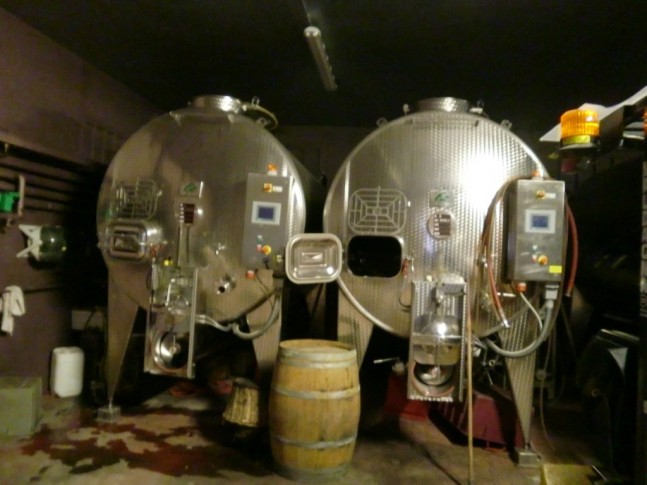
E Pira Roto-fermenters
Germano Ettore
For a profile on German Ettore, go to http://www.thewanderingpalate.com/profiled-wineries/the-diversity-of-piedmont-our-intrepid-singapore-sommelier-shalom-chin-goes-wandering-in-the-hills-of-piedmont/
*Langhe Nebbiolo DOC, 2010, 14%, €10
Medium garnet colour. Medium intensity on the nose, strawberries, fruity, confectionary and fragrant. The palate is med(+) alcohol, dry, sweet fruit, confectionary, juicy, strawberries with lots of flavour extract, medium acid, med(+) length, juicy finish.
Stainless steel ferment. There is no cold soak or whole berry ferments.
**Barolo DOCG “Prapò”, 2007, 14.5%, €36
Medium intensity orange colour. Medium intensity on the nose, concentrated, complex, black tea, fragrant, prunes, lifted with slight ethyl-acetate. The palate is high alcohol, med(+) acid and tannins, lots of power, hard tannins, chalky texture, mid palate of redcurrant fruit, long length, light strawberry finish which is subtle.
Clay soils.
**Barolo “Cerretta”, 2007, 14.5%, €36
Medium garnet colour. The nose is developed, mushroom, truffle, liquorice, blackberry and black tea, very concentrated, complex and fragrant. The palate is high tannins, hard and carpet texture, mushroom, med(+) acid, high alcohol, meaty, lots of structure, very powerful, savoury and light cherry, long length, meaty finish and complex. There is a lot of structure in this wine with heavy, full body flavours and a mushroom mid-palate. The fruit is balanced with the other elements and well-extracted.
Heavy clay soil.
***Barolo “Serralunga”, 2005, 14%, €27
Medium orange colour. Floral on the nose with tar and rose petals, developed, very complex and pretty, leather, light cherry, forest floor. The palate is spicy, with med(+) tannins and powdery texture. Good fruit and excellent flavours of black tea and a very good spectrum of complex flavours. Very long length and a complex savoury finish. Hints of liquorice.
Fermented at 27 degrees Celsius over 29 days and post maceration of 20 days. MLF is done in the tank.
Wines tasted at the Enoteca Italiano
***Corino, Barolo (La Morra), 2007, 15%, €25
Med orange colour. Nose of med(+) intensity, vanilla, cedar, caramel, blackberry, feminine, lifted, slight ethyl-acetate, so complex and floral, dried petals, a bright nose. The palate is high acid, med(+) tannins, smooth, drying, high alcohol, blackberries, sweet cedar oak, lacquered flavours, caramel, long length. Very delicate finish with slight oak and toast, a sort of black tea flavours.
Nebbiolo d’Alba spends a minimum of 12 months in oak. It is for people outside the Barolo and Barbaresco zone. Langhe Nebbiolo can contain Barolo or Barbaresco zone. This is a declassified Barolo.
Barbaresco Producers
Cantina dei Produttori del Barbaresco
Although the Cantina is considered as a co-operative, it only makes wine in good vintages. In 1958, the Priest of the village of Barbaresco persuaded 19 families to pull money together to make very good wine. The first three vintages were made in the church basement before moving to a proper winery. They considered the wines produced to be unique and called it Barbaresco. Members in the group are restricted to only those who contribute Nebbiolo. The farmers of the Co-operative own some of the best vineyards and do not produce a Langhe Nebbiolo unless it is a very bad year. I was told that it is about once every decade that a Langhe Nebbiolo is produced by them. Today, there are 53 families in the Co-operative.
*Langhe Nebbiolo DOC, 2010, 13.5%
Medium ruby colour. Lightly floral, medium(+) intensity, lifted, light herbs, very sort of Grenache-like. The palate is medium flavour intensity, med(+) acid and alcohol, light flavours of cherry, spice, spice, medium tannins, medium length, light in the back palate.
The vines are less the 15 years old.
Barbaresco, 2007, 14.5%, €15
Med(+) ruby colour. Light cherry nose, liquorice, cedar, complex, med(+) intensity, cherry, rhubarb, a sort of forest floor. The palate is med(+) tannins, lots of chewiness, med(+) acid, dark cherries, a slight forest floor quality, med(+) length, juicy finish, dry tea.
Barbaresco, 2006, 14%, €15
Med(+) garnet colour. Developing nose, forest floor, medium plus intensity, more leather and lead, slightly lifted. The palate is med(+) tannins, chewy, slightly hard on the palate, med(+) acid and alcohol, long length, autumn lift finish, dried herbs in the back.
Barbaresco, 2005, 14%, €16
Deep garnet colour. Nose is developed, mushroom, forest floor, high intensity, but subtle, wood smoke. The palate is med(+) acid and tannins, chewy, very long length, dry black tea finish, savoury.
Cantina La Ganghija
La Ganghija (meaning grape tendrils) of Enzo Rapalino is a producer based in Treiso, Barbaresco. He owns 18 hectares of vineyards which is considered huge in the region of Barbaresco. Being part of the fame five group of young winemakers called Langa style, Enzo started making his own wines in 2004. He started off with 6000 bottles and toady, he produces 6 different wines of 25000 bottles. It was only 3 years ago that he started on the building of his chai room (the aging cellar).
Enzo’s Chardonnay and Dolcetto are all made in temperature-controlled stainless steel tanks. His Barbera d’Alba is aged in barriques but his Nebbiolo is aged 2 years in big barrels. He uses Taransaud, Beaune (Quintessence), and Allier – all medium toast.
In 2011, the grapes were harvested early as it was particularly sunny.
The Cantina makes Chardonnay, Dolcetto, Barbera & Nebbiolo d’Alba, Barbaresco and late-harvest Moscato.
*Nebbiolo d’Alba DOC, 2009, 14.5%, €7
Med garnet colour. Nose of cracked black pepper and spice, medium intensity, fragrant, aniseed, cumin, cardamom. The palate has lots of flavours, spice, lots of mixed all-spice, medium intensity of flavours, drying sensation, puckery texture, high tannins, medium acid, medium length, savoury finish, mid-palate sweetness.
The vineyard is 18 years old.
**Barbaresco, 2008, 14.5%, €16
Med(+) garnet colour. The nose is floral, cedar, rose petals, lifted, med(+) intensity, lightly black tea, a light cigar smell, subtle, light cherries, classy. The palate has very good structure, packed full of flavour, med(+) acid, spicy and lifted, with a slight ethyl acetate note, chewy tannins, very delicious fruits and full of light complex flavours, long length, unbelievably complex back palate of light tar, leather. An elegant finish.
On a second tasting of a new bottle done in March 2012:
Med plus garnet colour. The nose is light leather, med plus Intensity, a polished wine, menthol, fumy, dark cherry like cola, a sort of fennel, aniseed, liquorice , complex, needs decanting but after 2 hours it is powerful and classy, with slight animal. The palate is cherries, very classy, high tannins, dries the mouth, puckery, lots of aniseed, cigar, high alch, med plus acid, light cedar, light dill, liquorice, lead and spices, long length, a finish that is structured with some coffee notes and lead. After 3 hours, develops into beautiful cherry chocolate cake flavours.
15 days of ferment and 1 week of post-maceration, MLF occur naturally in tank and then it was put in old barrels for 2 weeks. The barrels are 25hl and 100hl for first year and then 7500l barrels in the 2nd year. Two different crus are used. Giacosa has strong tannins and less colour while Bricco di Treiso is more elegant, has more colour and less tannins. 50% of each cru is co-fermented to give a stronger body to the wine. The ferment temperatures are 30-32°C. Like La Morra in Barolo, the soils are sandy and chalky but with more sand than clay soil than Barolo. It is 400m elevation. The days here are hot but nights are cool.
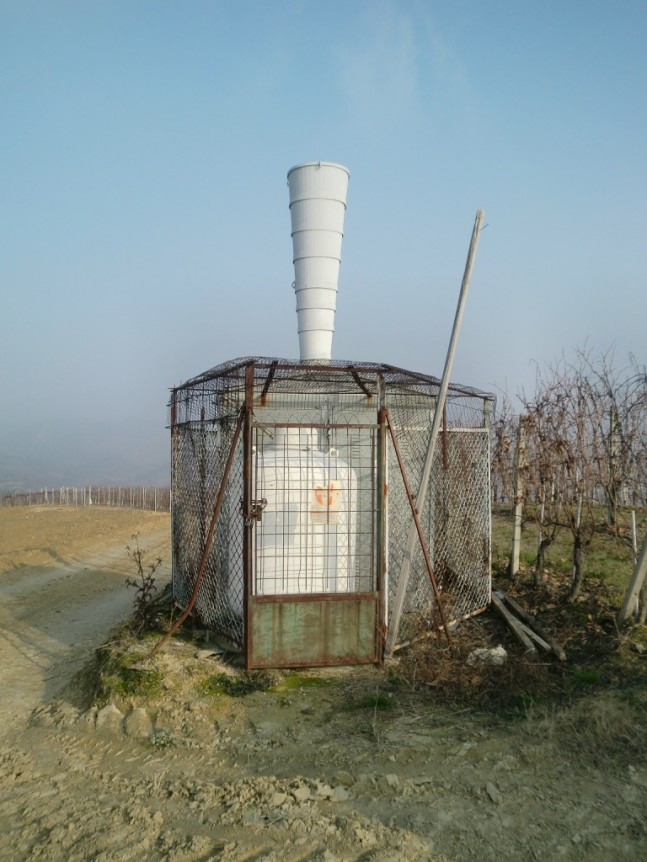
Hail machine to shoot salt up in the air to open clouds To disperse clouds this is done 4-10 times
Fontanabianca
The estate makes Arneis and Dolcetto d’Alba as well.
Langhe Nebbiolo, 14%, 2010 (bottled one month ago)
Medium orange colour. A light lacquered wine, light violets, medium minus intensity, light wood and cinnamon. The palate is high tannins, chewy and slightly rough, wood, med(+) acid, med length, still slightly closed on the palate.
Spent 6 months in big cask and less time on skins. Stainless steel ferment at 19-21°C at very low temperature as 22-33°C extracts more tannins. 35 days of fermentation. The young vines are declassified as Langhe or if it is 4-9 years before ready to release. This is from a less desirable part of the vineyard.
Barbaresco “Serra Boella”, 2008, 14%
Med plus ruby colour. Med(+) intensity on the nose, minty, earth, sweet herbs and bursting of red berries but still like a baby in terms of development. The palate is high tannins, puckery texture, high alcohol, forceful back palate, Med(+) length, mushroom, mushroom and wood characters with a tight tannic back palate.
33 hl oak is used and a little is shaved every 6 years. Canton Cooperage is used. Some barrels are 10 to 33 hl and some are Slovenian. The limit of the barrels is around 70-80 hl. The shape of the barrel is more for space of the wine.
Barbaresco “Bordini” 2008, 14%
Deep ruby colour. Cedar nose, light mint, med(+) intensity, earthy, tannic smell. The palate is high tannins, puckery, med(+) acid, tannin flavoured back palate (like black oolong tea), lead finish, mushroom funghi finish. This wine is all about structure.
Aged in 25% are new barriques.
*Barbaresco “Bordini” 2007, 14%
Medium garnet colour. Mushroom nose, solid earth, medium intensity, cedar, vanilla, subtle. The palate is complex, meaty, light caramel, savoury, high tannins, but much smoother than the 2008, beautiful structure, med(+) acid, high alcohol, long length, cedary and funghi back palate, very structured and smooth in the back.
Note: Barbaresco is harvested first before Barolo. This can be up to 6 weeks difference.
Natural and added yeast from the enology school in Alba are used. Pump-over is done 3 times a day and once a day for the last 2 to 3 days of ferment. The total days of fermentation are 40 days at 19-21°C. Some cold maceration is done. All the grapes are de-stemmed. No table sorting is done.
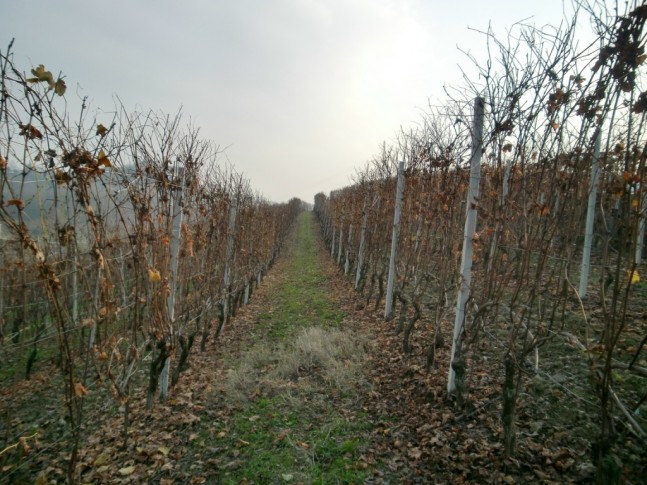
Rows of vines at Pelissero Pasquale
Pelissero Pasquale
*“La Ferma”, Langhe DOC, Freisa, 2009, 13.5%, €5.50
Med(+) ruby. Expressive nose, medium plus intensity, light perfume, dates, raisin, some leather, sweet nose. The palate is high tannins, drying tannins, tastes off-dry but it is due to the fruit as it is less than 2g/l sugar. Flavours of candy, raisin, cherry, chocolate finish, medium plus length.
Note: The Freisa grape is a cousin of the Nebbiolo.
“La Ferma”, Langhe DOC, Freisa, 2010, 13.5%, €5.50
Med(+) ruby colour. Cherry and vanilla nose, medium intensity, earth. On the palate, medium intensity and alcohol, mushroom, cherry, medium (+) tannins, slightly rough texture, medium length. Not getting much on the palate.
“Corsè”, Nebbiolo, 2010, 13%, €5
Pale red. Light tea and redcurrant aromas. The palate is med(+) acid, heavy on the palate and med length, med alcohol, light confectionary finish. Mid-palate could use more flavour.
A Vino Table, 24 hour skin contact and bleeding. No more IGT in Piedmont
Langhe Nebbiolo “Posqualin”, 2009, 13.5%
Deep ruby colour. Nose of dark herbs, med(+) intensity, light cedar, plums, smoke. The palate is med(+) alcohol, acid and tannins, carpet like texture, cedar, smoke, blackberry, plum, long length, plum-like palate.
The grapes are actually from Barbaresco. Aging is in one year old barriques.
Barbaresco “Brico San Giuliano”, 2008, 14%
Deep ruby colour. Lead nose, med(+) intensity, slightly lifted, cherry spice, slight asphalt. The palate is med(+) acid, high alcohol and tannins, drying-like black tea, mouth-watering due to acid, med(+) length, a drying palate, juicy, lots of light fruit and cherries.
14-18°C ferments in barrels for 3 month. Allowed to add acid but does not happen here.
Cantina Del Bricchetto, Franco Rocca
Franco also makes Barbera d’Alba.
*Barbaresco “Cru Albesani”, 2007, 14%, €21
Med garnet colour. Beautiful cedar nose, floral, fragrant herbs, vanilla, so expressive, med(+) intensity, complex. The palate is chocolate, high alcohol, med(+) acid and tannins, cedar finish, structured, light rubber flavour, light cinnamon flavours, complex.
Yields are 5.5 tons/acre. A percentage was in 1 year old oak.
*Barbaresco “Cru Albesani”, 2007, 14%, €22
Med(+) orange colour. Peppermint chocolate nose, med(+) intensity, lots of expression, mint-like eucalyptus, light orange rind, beautiful expression, meat, coffee. The palate is med(+) alch and tannins, rubbery texture, lead, rustic, woody, not much flavour in the mid palate but they burst forth later, med(+) length, savoury.
“Serni Söri”, 60% Nebbiolo/40% Barbera, 2007, €10
Deep ruby colour. Nose of raisin, dried cherries, slight ethyl-acetate, med(+) intensity, a bit like Amorone. The palate is dry, light oxidative characters, med(+) acid and tannins, drying tannins, light redcurrants, med length, neutral finish. This is a VdT Alessia.
Boffa Carlo
“Paje” Barbaresco DOCG, 2008, 14%, €20
Medium orange colour. Medium intensity on the nose, slightly closed, meaty, light cherries, light micro-ox aroma, leather, lead, light spice. The palate is medium acid, light leather, tobacco, med(+) tannins, lots of rubbery texture, slightly monotonous mid-palate, med(+) length, a drying palate sensation.
Clay calcareous soil, with a S-E exposition. 15-18 months in Slovenian oak of 20-25 hl. This spent 5 months in the bottle. 20 years vine.
“Ovello” Barbaresco DOCG, 2007, 14%, €25
Med(+) orange colour. Nose of medium intensity, light barnyard, meaty, oak aroma is more apparent than Paje, meaty character and sort of earthy-clayish, dark chocolate. Palate of mushroom, med)+) acid, high tannins, lots of dry tannins, med length, savour mushroom style, quite balanced style.
Clay calcareous soil of West exposition. Same method of treatment as Paje. 33 years old vine.
“Paje”, Barbaresco DOCG, 2007, 14.5%, €20
Med garnet colour. The nose is caramel, vanilla, forest floor, med(+) intensity, the fruit is hidden underneath and does not seem to bounce off the glass. The palate is med(+) acid and tannins, light micro-ox barrel flavour, med(+) length, light blackberry flavours, mid palate is more expressive of earth in it.
Cascina Roccalini
**“Roccalini” Barbaresco DOCG, 2008, 15%
Medium garnet colour. Nose is smoked meat, medium(+) intensity, a dense wine but closed on the nose initially. Meaty aromas, mushroom and tar. The palate is high alcohol and tannins, drying sensations, latex texture, blackberry, smoked meat, black tea, long length, meaty and savoury, underlying blackberry and bramble wood. The mid-palate is complex with a mushroom, truffle finish.
This vineyard is next to Anjelo Gaja. It is has unbelievable potential.
After an hour, the aroma has completely evolved.
The nose is fragrant, very expressive of lead, high quality chocolate, blackberry, light cedar, perfume, slightly polished and a very light berry aroma. The oak regime in this wine is good. The palate is balanced, very light-hearted, high alcohol and med(+) acidity & tannins, latex texture, long length, leather and blackberry finish, lots of light savoury flavours.
This is a good example of Nebbiolo which is tannic but can be drunk young.
Roero Nebbiolo Producers
Matteo Correggia
Matteo Correggia is a well-known producer in the Roero region. Matteo himself is a man who has taken lots of risk and investment into the wines he has produced. During a time when people did not think highly of Roero’s terrior, Matteo believed in the land and today, he has proved his naysayers wrong. Walking through the cellars of Matteo, I realised that this is a man who has given a lot of thought into the process of making quality wines. The land which grows grapes has a lot of chalk and limestone marl, higher than any vineyard I have seen in Piedmont so far.
Some of his vineyard, located at the edge of Canelli, is at an elevation of 350 metres, which is lower in altitude compared to Langhe. The soils of Roero are younger than Langhe. The Arneis is planted lower on the slope as it is cooler but more prone to frost. The top of the hill is for Barbera. His Marun Barbera vineyard which is south-facing on a sandy soil is used to produce his Barbera d’Alba. The plantings of his Barbera are 3ft vine spacing x 8 ft row. For hills which are S-E facing, N-S row orientation is used. Usually, Matteo leaves one grape on each cane, which is about 5 bunches per vine. The density of his plantings are 4500 vines/ha, producing a maximum of 10 tons/ha for Barbera d’Alba and 8 tons/ha for Roero DOCG. For his new plantings, he is looking to increase the vine density. His old plantings are 4 ft row x 2 ft vine spacing. With an angle of 35°, the steeps slopes require the use of baby tractors. The driller used to position the poles is larger in diameter as the sandy soil collapses into the hole faster and makes it difficult to put the pole in.
Veraison takes place in August and green Harvest occurs at the end of July to early August. At the start of September, the Arneis is harvested and in mid-September, the Barbera is next. The Nebbiolo is harvested in mid-October. The harvest for 2011 started early, on the 29th of August.
Matteo uses Roto-fermenters but with no long maceration and for his Nebbiolo, he ferments on skin for a maximum of 10 days. The Arneis goes through automatic battonage and is fermented with the lees in the roto-fermenters. Both the Arneis and Sauvignon Blanc are fermented around 14 to 17°C. His red wines are fermented at 27 to 28°C. Some of his Nebbiolo is fermented on skins in spinning barriques. Boutes, Slyvain, Mittelberger, Pauscha (Austria), Quintessence are among the brands he uses. The barrels are stored in a controlled cellar of 81% humidity and 15.4°C.
Matteo also makes Sauvignon Blanc, Brachetto, Barbera d’Alba, and a Bordeaux Blend.
*Roero DOCG, Nebbiolo, 2009, 14%, €10
Pale garnet colour. Lifted nose of rose petals, light cherries, med(+) intensity, light lead, very fragrant. The palate is med(+) tannins, light drying sensation, med(+) acid, light chewy flavours, light earth, med length, very light mid-palate, light herbs in the back, earthy.
On 60-70% sand and the rest is clay and limestone. Roero is mostly sandy soil.
Nebbiolo d’Alba “La Val Dei Preti” DOC, 2009, 14%, €18
Pale orange colour. Light fruit nose, light morello cherries, and pepper spice, some sort of earthy-clay smell. The palate is high tannins, rubbery texture, light cherry spice and cloves, quite delicate at the same time, Med(+) length, a sort of light clay earthiness on the flavour profile.
18 months in 50% new barrels. The soil is 3% clay and the rest is sand and stilt. This is a south exposure at 280 m with 6000 vines/ha.
*Roero DOCG Riserva “Ròche D’ampsèj”, Nebbiolo, 2007, 14.5%, €27
Med(+) orange colour. A light cedar and leather aroma, med(+) intensity, light floral characters, jasmine, cinnamon, good fruit and aniseed. The palate is leather, med(+) acid, high tannins, puckery structure, med-palate of cherries, med(+) alcohol, med(-) length, slight aniseed and clove character.
18 months was in barrels and 2 years was in the bottle. The wine comes from more sandy soil at 5000 vines/ha. It is on a hill SE to SW at 300 m.
Cascina Ca’rossa di Angelo Ferrio
Based in the East of Canale d’Alba, the centre for Arneis in heart of the Roero region, Angelo Ferrio is a man who is passionate about Roero’s identity. His wines are of very high quality and even his 2009 Nebbiolo from the barrel was looking balanced with flavours of truffle. I passed a comment about how much better his white wines could get if he does less filtering to his wines. This spurred Angelo into a frustrated tirade against how consumers were complaining that wines had to be clear and not cloudy and how he had to filter the wines just to prevent the wines from being hazy. This would be easy for the reds but not for the whites. Angelo is an example of being a victim of consumers pursue wines visually, thus compromising the possibility of more complex flavours and mouth feel. We tasted his white wines from the tank and true enough, the tank samples were brighter and more expressive. Not only his Arneis had a rounder texture, but even his Nebbiolo had more fruit in it. The samples were fresh, fruitful, bright and expressive. Already producing great wines, I can only imagine the potential of his wines if he did away with filtering.
After returning from military service, Angelo started his first proper bottling in 1995. The family owns 13 hectares of vineyards with over 7000 vines/hectare and more than 60 000 bottles produced annually. Roero soon became a DOC in 1985 and then in 2005, it became a DOCG. According to Angelo, 2007 was an easier year than 2008 but the 2008 was more tannic. 2009 was more balanced. There has been no bad vintage in a decade but changes in the wine structure.
All wines are fermented in steel and Angelo uses 25hl barrels. His Barbera, for example, is aged in the Slovenian 25 hl barrels and also some goes to Pauscha oak (Austria). He has been farming biologically for 7 to 8 years and was certified organic in 2010. For his reds, he uses natural yeast. He ferments his red grapes which is considers less structured at 25-28°C and his Nebbiolo at 28-33°C
Langhe Nebbiolo DOC, 2010, 13.5%, €7.50
Pale garnet colour. Medium intensity aroma, slight earth, tar smell, berries and black tea-like aromas. On the palate, medium tannins, med(+) acid, soft, med(+) alcohol, light cherries, med(+) length, light confectionary finish and slight red currants.
15 days of skin maceration is done. The vineyard is at Canale, 200-250 m above sea level at south and SW exposition. The soil is chalk and clay. Aging is 6-8 months in used barriques, blending in steel vats and 2 months in the bottle.
*Roero DOCG “Audinaggio”, 2009, 14.5%, €16.50
Medium garnet colour. Med(+) intensity, light cedar, oak-barrel aged, leather, black tea, lifted, light cherries like a medicine. On the palate, med(+) acid, high alcohol, med(+) tannins, soft and light latex textures, slightly sticky, long length, a subtle finish of light earth and dark cherry finish, beautiful back palate of earth and leather.
3900 bottles made. 30 days maceration and 18 months aging in barriques 50% new. This wine will look interesting after 10 years. Produced in Vezza d’Alba, 220 – 270 m, SW exposition, mostly sandy soil. 18 months in barriques, and 4 months in the bottle.
**Roero Riserva DOCG “Mompissano”, 2008, 14%
Medium ruby colour. Med(+) intensity on the nose, black tea, earth, light confectionary and soap characters, prunes. The palate is med(+) acid, medium alcohol, high tannins and slightly hard, structured on the mouth, an earthy and herb finish, long length, subtle mid-palate of confectionary, tannins are slightly hard but surprisingly the mid-palate is not as heavy as one expects. A juicy finish. Elegant.
Note: The 2007 was an easier vintage than the 2008 and the 2008 more tannic.
***Roero Riserva DOCG “Mompissano”, 2007, 14.5%
Medium ruby colour. Med(+) intensity on the nose, light leather, delicate, light cherries, tar, subtle but complex, very delicate, black tea with a slight lift. The palate has high tannins and drying, puckery texture, med(+) acid, high alcohol, lots of subtle flavours of light cherry flavours, structured and complex, very delicate wine with a long length. Light cherries and leather with a very subtle back palate finish. Beautiful delicate flavours. Examples of an elegant Nebbiolo and spice. A well-balanced wine that will improve with time.
250-300m above sea on chalk and clay, SW exposition. 18 months in 30hl Slavonian oak, blending in steel vats and 4 months in bottles. 10 000 bottles produced.
Giovanni Almondo
Roero DOCG, Nebbiolo, 2009, 13.5%, €8
Medium ruby colour. Nose of leather, earth, medium intensity, light cherries, lifted. Palate of med(+) acid and tannins, semi-hard tannins, latex texture, light cherry, medium length, very light and earthy finish, slightly savoury.
12 months in 2 years old barriques and 6 months in big Slovenian oak. It is interesting to see their wine influenced by their barrel regime.
**Roero DOCG “Bric Valdiama”, Nebbiolo, 2008, 14%, €17
Medium ruby intensity. The nose is lifted strawberries, med(+) intensity, light spice, very beautiful aromas of black tea. The palate is med(+) acid, high alcohol, rich, chocolate, mid-palate is strawberries, med(+) tannins, slightly rough, good structure, very nice leather and tar, liquorice, black tea, long length. A black tea finish with a beautiful solid back palate of liquorice.
This wine has been aged in one year new barrique and 6 months in Slovenian oak of 25 hl. 10 days of maceration in skins and 28 to 30 degrees ferment.
**Roero Riserva, 2006, 14%, €18
Pale brick garnet colour The nose is expressive and lifted, feminine, leather, mushroom, light truffles, strawberries and cedar. The palate is med(+) tannins, slightly drying texture, med(+) acid, high alcohol, lots of mushroom, truffle flavour, meaty, with light cedar palate, very long length, black tea flavours, very structure wine.
**Roero Riserva, 2008, 14%, €18 (1 month before release)
Med(+) purple colour. The nose is fruit forward, light red currants, some floral lift, hidden candy, sweet smell, light lolly, leather, light barrel, complex, lacquered fruit. The palate is med(+) tannins, high alcohol, light spice, chewy mouth feel, carpet, red currants, liquorice, med(+) length, very well structured.
Other Nebbiolo Producers
Osvaldo Barberis
Osvaldo also produces Dogliani and Barbera d’Alba. For my notes on his Barbera, go to http://www.thewanderingpalate.com/profiled-wineries/dolcetto-in-piedmont-%e2%80%93-not-a-sweet-wine/
Nebbiolo d’Alba “Muntajà”, 2009, 14.5%, €7.50
Med ruby colour. Nose of truffles, med(+) intensity, black tea. The palate is high tannins and sucks the life out of you, rubbery texture, med(+) intensity of fruit, prunes, more dark than bright in terms of life on the palate.
30% was in barrels and the rest in stainless steel.
Anna Marie Abbona
For more on Ana Marie’s profile, go to http://www.thewanderingpalate.com/profiled-wineries/dolcetto-in-piedmont-%e2%80%93-not-a-sweet-wine/
Anna Marie also makes Nascetta, Riesling and Dogliani.
“Rosà”, Nebbiolo, 2010, 12.5%, vino rosato, €7.50
Pale rose colour. Nose of funghi mushrooms, med(-) intensity, slightly “foxy”. This wine has a juicy palate, med(+) acid, and med alch, spicy, redcurrants, long length and a juicy finish.
This wine has been fermented without the skins. Does that mean the colour is in the juice.
*Langhe Nebbiolo, 2008, 14%, €12
Medium garnet colour. Nose is lifted, strawberries, spicy, wholesome and juicy, light smoke, floral, sweet candy, like a rose. The palate is med(+) acid and high alcohol, light Pinot Noir-likeness on the flavour, long length, juicy, lots of strawberries. This is a very excellent wine.
South facing slopes. The barrels are 10hl or 25 hl for aging. Sometimes, 50% new barrels are used.
Mustela
For Mustela’s profile, go to http://www.thewanderingpalate.com/profiled-wineries/moscato-mania-the-little-rascal/
“Magistri” Langhe Nebbiolo DOC, 2008, 14%, €12
Med(+) ruby colour. A nose of cloves, medium intensity, fruit is hidden but the aromas are subtly thee, slightly unfocused, the aromas come and go as if it is unsettled. The palate is med(+) acid, high alcohol, med(+) tannins, velvety and very smooth texture, light cedar and chocolate mid-palate, med(+) length, dark fig finish, hidden flavours.
The grapes are from, Treiso, next to Barbaresco. IT has 24 months in barriques, 1/3 new, 1/3 one year old and 1/3 2 year old.
Note: Due to the slight variation in this bottle, I requested a second bottled to be opened. Below are my notes for the new bottle, which seems much better.
A nose of light cedar, cherry spice and leather, med(+) intensity, a light fruit, chocolate plushness to it. On the palate, med(+) acid, alcohol and tannins. Velvety texture and fruit that is hidden beneath the wood but will start to reveal itself in time. I prefer this with less oak. There are hints of toast, lead flavours, med(+) length but again, the fruit flavours are hidden behind the oak in the back palate. Perhaps time will help soften the oak aroma.
Wines tasted at the Enoteca Italiano
*Giovanni Rosso, Langhe Nebbiolo DOC, 2010, 14.5%
Med(-) orange colour. Nose of med(+) intensity, some candied fruit, some lead and light mushroom, light tree moss, very forceful and also subtle at the same time, blackberry and quite feminine and generous. Med(+) acid on the palate followed by high alcohol, med(+) tannins that are quite smooth in the mouth, black tea, liquorice, dark cherries, med(+) length, cherry finish. It has an amazing finish which fades away quickly and then comes back again because of the alcohol in the back. Slight truffle back palate. The tannins are quite big in the back but not as apparent on the mid-palate.
Note: This is a declassified Barolo
Many thanks to Robert & Leslie Alexander for pointing me in the right direction and for taking the time to explain about Piedmont. You can check them out at http://www.travellanghe.com/
I would also like to thank the producers for taking the time to give me a tour of their vineyards and for allowing me to interview them. Matteo Capellaro for explaining to me the subtleties of Barolo.
|
|
Tweet |






No comments to Sommelier Shalom Chin shares his Thoughts on Piedmont Nebbiolo | Comments Feed
No comments yet
The comments are closed.